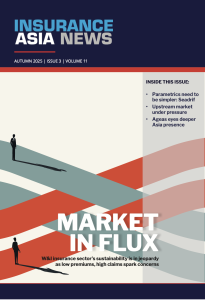APAC insurance M&A to be fuelled by regulatory scrutiny, private equity
January 15 2025 by Jon Guy and Joana Nguyen
The insurance industry’s M&A activity in the Asia region is likely to become more active in 2025, driven by factors such as market growth potential, regulatory changes and shifts in the industry environment, market sources told InsuranceAsia News (IAN).
“Although many external activities were restrained during the Covid-19 period, insurers that have adapted to the high-inflation and high-interest-rate environment may now consider entering new markets,” Anita Bong, APAC financial services insurance sector leader at EY, told IAN.
While in mature markets like Japan and South Korea, where the industry is nearing saturation, companies are seeking to grow through M&A to expand market share or integrate new business models, emerging markets such as Indonesia, Vietnam and the Philippines, present significant growth potential, Bong added.
“Global insurers are likely to accelerate their market entry through joint ventures or acquisitions with local partners in these high-growth regions,” she said.
The advancement of digital investments is also expected to drive an increase in the acquisition of insurtechs, Bong added.
“In what can be described as a ’data war’, the assets of these insurtechs are highly attractive due to their technological capabilities in data analytics and innovation,” Bong said.
In the overall context of a downturn in large-cap M&A transactions, large carriers still have significant M&A war chests and continue to strategically reposition themselves, law firm DLA Piper said in its annual review of the M&A sector.
Regulatory compulsions
Regulators across Asia Pacific are also expected to have a profound effect on the M&A market this year, with brokers and insurers set to see potential consolidation.
Smaller insurers could also find it challenging to meet the higher capital requirements under the new regimes in markets, like Indonesia, as well as Hong Kong.
In Indonesia, the new equity requirements for 2026 are also likely to encourage competition and spur consolidation with some weaker insurers to fall short of requirements.
The country’s regulator Financial Services Authority (OJK) has mandated all insurers to hold a minimum of IDR250 billion (US$15.3 million) in equity capital by 2026, which is 67% higher than the current level. This will be increased to between IDR 500 billion and IDR1 trillion by 2028.
Requirements for reinsurers would also rise to IDR500 billion by the end of 2026, from IDR100 billion, which would be stepped up to IDR2 trillion by 2028. Those that offer credit insurance would also face a higher-tier minimum.
The country’s insurance market is fragmented with 49 life insurers and 72 non-life insurers as of the end of 2023. This has led to aggressive business expansion, which weakens insurers’ pricing power and profitability.
Analysts said the increasing capital demands would prompt a round of mergers and acquisitions as current participants look to ensure they have the assets to meet the new rules.
While in Hong Kong, the Insurance Authority (HKIA) had introduced a risk-based capital (RBC) regime from July 1, 2024, which is likely to spur deals.
“Consolidation within local insurance markets through M&A activities is expected to occur, as smaller players seek partners to help strengthen their capital position," said Heng Loong Cheong, Hong Kong partner at DLA Piper.
"This consolidation could help reduce the high number of authorised insurers in Hong Kong, according to the latest HKIA statistics which reported a total of 157 authorised insurers as of May 23, 2024."
The broking sector in the city is in a similar situation, with 804 brokers as of May 31, 2024, many of which are SMEs and operated directly by their founders.
“The Hong Kong broker market is also poised for potential consolidation. Licensing fees of brokers would be payable to the HKIA starting September 23, 2024, under the insurance amendment regulation 2024, which would impact the sustainability of many of the smaller brokers," Cheong added.
"M&A activity is therefore anticipated as smaller brokers may seek to be acquired by their larger peers to improve economies of scale, diversify distribution channels and absorb the regulatory costs."
"We expect that the new regulations coming into force at the start of 2026 are likely to drive further consolidation in 2025 as efforts are made to conclude deals before the end of the year." Lyndon Masters, DLA Piper
His views were echoed by EY’s Bong, who agreed that new solvency regimes, such as China’s C-ROSS II and South Korea’s K-ICS, are creating challenges for small and medium-sized insurers, forcing them to seek additional capital or undergo restructuring, which means financially weaker companies are likely to be acquired by or merge with larger players.
In Australia, new regulations, which will come into force on January 1, 2026, will see regulators placing insurance M&A activity under far greater scrutiny.
“We expect that the new regulations coming into force at the start of 2026 are likely to drive further consolidation in 2025 as efforts are made to conclude deals before the end of the year,” said Lyndon Masters, a partner with DLA Piper in Australia.
This is after Australia has already seen a flurry of activity in the past 12 months, with Ardonagh Group’s acquisition of PSC the biggest deal.
"The past 12 months have been very much about broker consolidation, with players looking for both size and opportunity," Masters added.
“While we have seen some significant deals for Australian companies, we have others who are looking at offshoring with deals in the US, UK and Europe and we expect this to continue.”
Private equity
Private equity (PE) funds remain one of the primary drivers of the M&A recovery due to significant dry powder.
PE firms and investors, drawn to the growth potential of the Asian insurance market and its relatively low insurance penetration rates, are likely to seek strategic acquisition opportunities, especially in markets with high profitability or rapid growth, according to EY’s Bong.
"Private equity funds are now often seen in the bidding processes of insurance carriers and intermediaries being auctioned and are actively looking for opportunities to invest in APAC," said DLA Piper's Cheong.
“Despite the global trend of increased focus by regulators, and potential impact on timeline, we believe regulators will remain open to PE-backed acquirers that demonstrate a long-term commitment to the business and alignment to policyholders’ interests."
This trend continues from the previous years, when M&A activity in the region was defined by an increase in PE funds-backed deals, with private equity funds often seen in the bidding processes of insurance businesses being auctioned and actively looking for opportunities to invest in APAC, DLA Piper said in its annual review of the M&A sector.

“It may be less about buying a company, and more about buying books of business. That I would expect to continue because it is about freeing up capital and redistributing risk.”
Erik Bleekrode, KPMG
Among notable deals supported by private equity in the past few years was Oona Insurance completing acquisitions in the Philippines and Indonesia after being supported by global investor Warburg Pincus in October 2022.
In Fosun International’s second attempt to sell Hong Kong-based Peak Re in 2024, the prospective bidders were believed to include mainly private equity firms as well as some other financial investors, DLA Piper said in its review.
Several PE-backed reinsurers also tapped into Asia’s life insurance market, such as the JPY574 billion (US$3.6 billion) reinsurance transaction between Global Atlantic backed by KKR and Manulife Japan involving the transfer of life blocks and reserves.
“We also understand that there are more structured reinsurance deals in the Japan and Korea markets, for instance RGA, with Blackrock and Vanguard as its two largest shareholders, has reached an agreement with Tongyang Life Insurance Company for an RGA subsidiary to reinsure a US$144 million in-force block of life policies through coinsurance, marking the first cross-jurisdictional coinsurance transaction in South Korea,” the review said.
Legacy deals
The market will see more reinsurance transactions similar to last year with General Atlantic or BlackRock wanting to reinsure large parts of insurers’ businesses as they aim to free up capital, according to Erik Bleekrode, head of insurance in APAC for KPMG.
“It may be less about buying a company, and more about buying books of business. That I would expect to continue because it is about freeing up capital and redistributing risk,” Bleekrode said.
“These reinsurance transactions mostly happen on the life side because they are underlying long-term portfolios and they tend to take up a lot of capital.
"Moving them off your balance sheet could be attractive because it frees up capital.”
Bleekrode noted that such transactions also give the buyer access to large amounts of assets that they believe they would be able to get a slightly better return on due to their asset management capabilities.
-
Exclusive: Hong Kong housing estate fire property claim could top US$200m, with China Taiping the sole insurer
- November 28
Hong Kong firm provides the master property insurance for the Wang Fuk Court housing estate, as well as contractors’ all-risk policy, including third-party liability, and employee compensation cover.
-
Tighter solvency regimes, market disruptions driving Asian demand for structured solutions: Swiss Re’s Kaspar Mueller
- November 27
Capital motivation, volatility protection and leveraging capital for growth are key motivations for cedent's seeking structured programs, the reinsuer's CUO for structured solutions says.
-
Consolidation unlikely to slow amid shifting, costly regulatory landscape: Helvetia CEO Fabian Rupprecht
- November 26
Data centres, natural catastrophes and robotics 'are real opportunities' for growth, he also tells InsuranceAsia News.
-
Singapore must be ‘go-to-place’ for Asian clients, WTW Asia cargo head Oliver Scarr says
- November 25
Facing increasing competition from London market, the hub needs to provide solutions to complex and challenging marine risks as accounts migrate.
-
QBE | Elevating customer experience, humanising claims: QBE Asia’s ‘Solutions in a Box’
Vastly improving turnaround times and personalising service delivery, QBE Asia’s award-winning, end-to-end bundled claims solutions is a game-changer for the insurance industry.
-
Beazley | What does cyber protection look like from day 1 to day 600 and beyond?
Cybersecurity is no longer just an IT concern, but a governance issue that belongs on the boardroom agenda.
-
Sedgwick | Preparing for the next storm
Insurance industry needs to recalibrate, invest in innovation and strengthen systems, talent and data practices.
-
Peak Re | From climate modelling to market opportunity: Forging a new clarity on Southeast Asia’s climate risk
Southeast Asia's protection gap: a crisis of clarity, not just capital

